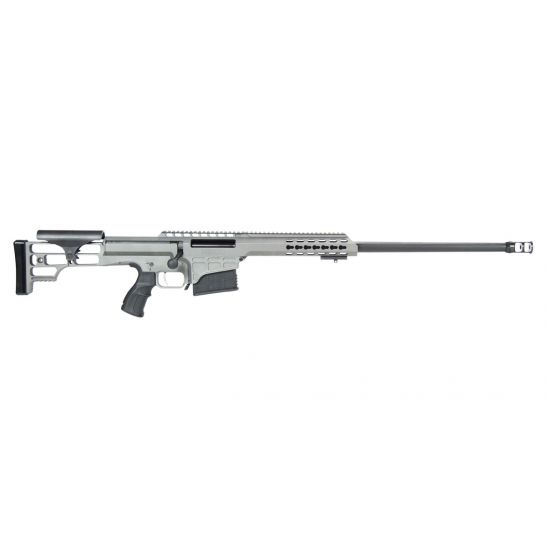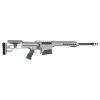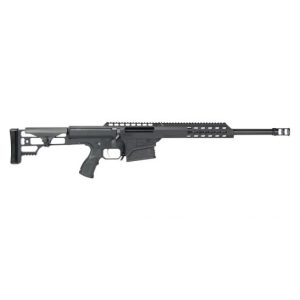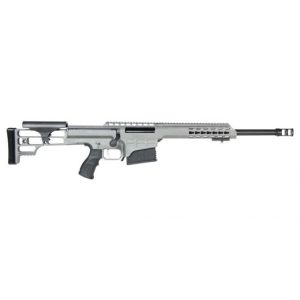Barrett M98B 24" .308 Winchester Bolt Action Rifle, Tungsten Grey Cerakote – 14803 For Sale
$3,727.98
What is the difference between the Barrett M98B and the M82?
The Barrett M98B and the M82 are both sniper rifles but differ significantly in design, purpose, and specifications:
1. **Design and Purpose**:
– **Barrett M98B**: This is a bolt-action sniper rifle chambered for the .338 Lapua Magnum cartridge. It is designed for long-range precision shooting, with a focus on accuracy and ergonomics for snipers.
– **Barrett M82**: Also known as the M107 in military use, this is a semi-automatic anti-materiel rifle chambered for the .50 BMG cartridge. It is intended to engage and disable equipment or vehicles rather than for precision sniping of individual targets.
2. **Action Type**:
– **M98B**: Bolt-action, which typically offers greater precision and reliability in a sniper role.
– **M82**: Semi-automatic, allowing for rapid follow-up shots, which is beneficial in its anti-materiel role.
3. **Caliber**:
– **M98B**: Chambered for .338 Lapua Magnum, known for its long-range accuracy.
– **M82**: Chambered for .50 BMG, a more powerful cartridge designed for heavy impact and extended range.
4. **Weight and Portability**:
– **M98B**: Generally lighter and more mobile, designed for use by a single marksman.
– **M82**: Heavier due to its larger caliber and semi-automatic mechanism. It is less portable and often used with a team or static position.
5. **Applications**:
– **M98B**: Primarily used for precision sniping in military or law enforcement.
– **M82**: Used to destroy equipment, penetrate light armor, and incapacitate vehicles, in addition to some use in long-range sniping.
Overall, the M98B is more suited for precision target engagement at long ranges, while the M82 is designed for anti-materiel purposes with its powerful .50 BMG round.
What caliber is the M98B sniper rifle?
The M98B sniper rifle is chambered in .338 Lapua Magnum.
What is the difference between the MRAD and the M98B?
The primary differences between the Barrett MRAD (Multi-Role Adaptive Design) and the Barrett M98B sniper rifles lie in their design purpose, modularity, and some specifications:
1. **Design and Purpose**:
– **MRAD**: Designed as a modular, multi-caliber sniper rifle. It emphasizes adaptability and can be configured for different operational roles.
– **M98B**: Originally designed as a precision long-range rifle specifically for .338 Lapua Magnum rounds.
2. **Modularity**:
– **MRAD**: Offers high modularity, allowing users to change barrels and calibers with minimal tools. This makes it adaptable for various missions and preferences.
– **M98B**: Has less modularity compared to the MRAD, being more focused on specific calibers and less flexible in field changes.
3. **Calibers**:
– **MRAD**: Capable of accommodating multiple calibers including 7.62 NATO, .300 Winchester Magnum, .338 Lapua Magnum, among others, through barrel and bolt group changes.
– **M98B**: Primarily chambered for the .338 Lapua Magnum, focusing on long-range precision shooting.
4. **Design Features**:
– **MRAD**: Features a fully adjustable folding stock and can be tailored in terms of trigger feel, cheek height, and length of pull.
– **M98B**: Features a fixed stock and offers ergonomic enhancements, concentrating on sniper-specific deployment.
5. **Usage and Deployment**:
– **MRAD**: Widely adopted by military forces due to its versatility and adaptability to various calibers.
– **M98B**: While also used by military and law enforcement, it is more niche in its application within specialized units that focus on long-range engagements.
Both rifles are designed by Barrett and maintain high standards of precision and reliability, but the MRAD offers greater versatility for users who require adaptability across different environments and calibers.
What is the price of Barrett sniper rifle?
The price of a Barrett sniper rifle can vary widely based on the model and market conditions. As of the last update, prices typically range from around $3,000 to over $12,000. For the most accurate and up-to-date pricing, it’s best to consult a licensed firearms dealer or the manufacturer’s website.
What sniper did Chris Kyle use?
Chris Kyle, the renowned Navy SEAL sniper, used several rifles during his military career. The most notable ones include the McMillan TAC-338, chambered in .338 Lapua Magnum, and the Mk 12 Special Purpose Rifle (SPR), chambered in 5.56×45mm NATO. He was also known to use the Mk 11, which is a sniper variant of the SR-25, chambered in 7.62×51mm NATO. Each of these rifles played a significant role in his effectiveness as a sniper.
Is it legal to own a Barrett M82?
The legality of owning a Barrett M82, a type of .50 caliber semi-automatic rifle, depends on the country, state, or region you are in, and the specific laws and regulations that apply there. In the United States, for example, ownership is generally legal at the federal level, but it is subject to various state and local laws. Certain states may have restrictions, require special permits, or ban the ownership of firearms like the Barrett M82 altogether.
It is important to research and understand the specific laws concerning firearm ownership in your area and ensure compliance with all legal requirements. Consulting local laws or seeking legal advice from a knowledgeable professional can provide the most accurate guidance for your specific location.
What rifle do Navy SEAL snipers carry?
Navy SEAL snipers often utilize a variety of rifles depending on the mission requirements. Some commonly used sniper rifles include the MK 11, MK 12, and MK 13. The MK 11 is a semi-automatic sniper rifle, while the MK 12 is a special purpose rifle. The MK 13 is a bolt-action rifle often used for long-range engagements. Additionally, SEALs may use other rifles like the M110 Semi-Automatic Sniper System and various versions of the Remington 700.
What sniper rifle does John Wick use?
In “John Wick: Chapter 2,” John Wick uses a TTI TR-1 Ultralight sniper rifle.
What rifle do USMC snipers use?
The primary rifle used by USMC snipers is the M40 series. The most recent model is the M40A6. Additionally, they have also used the Mk 13 Mod 7 sniper rifle. These rifles are known for their accuracy and reliability in various combat conditions.
Do US snipers use MOA or MRAD?
US snipers typically use MIL (milliradian) systems, which are often referred to as MRAD. This system is preferred by military and law enforcement snipers because it allows for quick and precise adjustments in the field. However, Minute of Angle (MOA) is also used and is more common in civilian shooting contexts. Ultimately, the choice between MOA and MRAD can depend on personal preference and specific mission requirements.
What does the MRAD stand for in Barrett?
In Barrett, MRAD stands for Multi-Role Adaptive Design.
What is Gibbs sniper rifle?
The Gibbs sniper rifle is a fictional firearm featured in the television series *NCIS*. It is the weapon of choice for the show’s main character, Special Agent Leroy Jethro Gibbs, played by Mark Harmon. The rifle is notable for its accuracy and power within the show’s narrative, although specific technical details or real-life equivalents are not provided.
What is the difference between the Barrett M107 and M82A1?
The Barrett M107 and M82A1 are both .50 caliber sniper rifles developed by Barrett Firearms Manufacturing, and they share many similarities. However, there are some differences between the two:
1. **Designation and Purpose:**
– The Barrett M82A1 is the original model, introduced in the early 1980s. It is designed primarily as an anti-material rifle, intended to disable vehicle engines, aircraft, and other equipment at long ranges.
– The Barrett M107 is a slightly updated version of the M82A1, adopted by the U.S. military as the standard anti-material rifle. It includes enhancements based on feedback from military use.
2. **Design and Features:**
– Both rifles generally have similar design characteristics, but the M107 may include improvements such as a revised muzzle brake, or enhanced optics mounts for better precision and reduced recoil.
– The M107 also frequently comes with newer accessory rails and stock options, often taking advantage of newer materials or ergonomic designs for improved usability in the field.
3. **Military Adoption:**
– While the M82A1 saw use in military and civilian applications, the M107 specifically reflects the U.S. military’s requirements and updates based on its combat usage, officially designated as the M107 when adopted.
Overall, the M107 can be viewed as an evolution of the M82A1, incorporating refinements and adaptations that respond to user feedback and changing military requirements.
What is the strongest sniper rifle in the world?
The strongest sniper rifle in the world is often considered to be the Barrett M82, also known as the M107 in military service, due to its powerful .50 BMG (Browning Machine Gun) cartridge, long-range capabilities, and widespread use among military forces. It’s renowned for its ability to penetrate armor and its effectiveness at targeting equipment and vehicles from a long distance. However, other sniper rifles like the CheyTac M200 Intervention, chambered in .408 CheyTac, are also praised for their extreme range and precision, making them strong contenders for this title.
What is the difference between the Barrett M90 and the M82?
The Barrett M90 and M82 are both rifles developed by Barrett Firearms, but they have some key differences:
1. **Design**:
– **M82**: Also known as the M82A1, this is a semi-automatic, recoil-operated rifle. It’s designed for long-range and anti-material roles and is known for its firepower, often used by military forces around the world.
– **M90**: This is a bolt-action rifle, meaning it requires manual operation of the bolt for each shot. The M90 is simpler and lighter compared to the M82, primarily due to its action type.
2. **Operation**:
– **M82**: Semi-automatic operation allows for faster follow-up shots as it automatically ejects the spent cartridge and chambers a new one with each pull of the trigger.
– **M90**: Being a bolt-action rifle, it requires the operator to manually cycle the bolt after each shot, which can be slower but often results in a more robust and potentially more accurate system for single precise shots.
3. **Usage and Purpose**:
– **M82**: Its semi-automatic nature makes it more suitable for scenarios where rapid fire is necessary or beneficial, such as engaging multiple targets quickly or in dynamic combat situations.
– **M90**: Geared towards precision shooting, it’s often favored for situations where accuracy is more critical than rate of fire.
4. **Deployment**:
– Both have been utilized by military forces, but their specific roles and deployment scenarios may differ based on the strategic needs of the force utilizing them.
Overall, the primary differences lie in their action type (semi-automatic vs. bolt-action) and the resulting implications for their use in different shooting scenarios.




Reviews
There are no reviews yet.